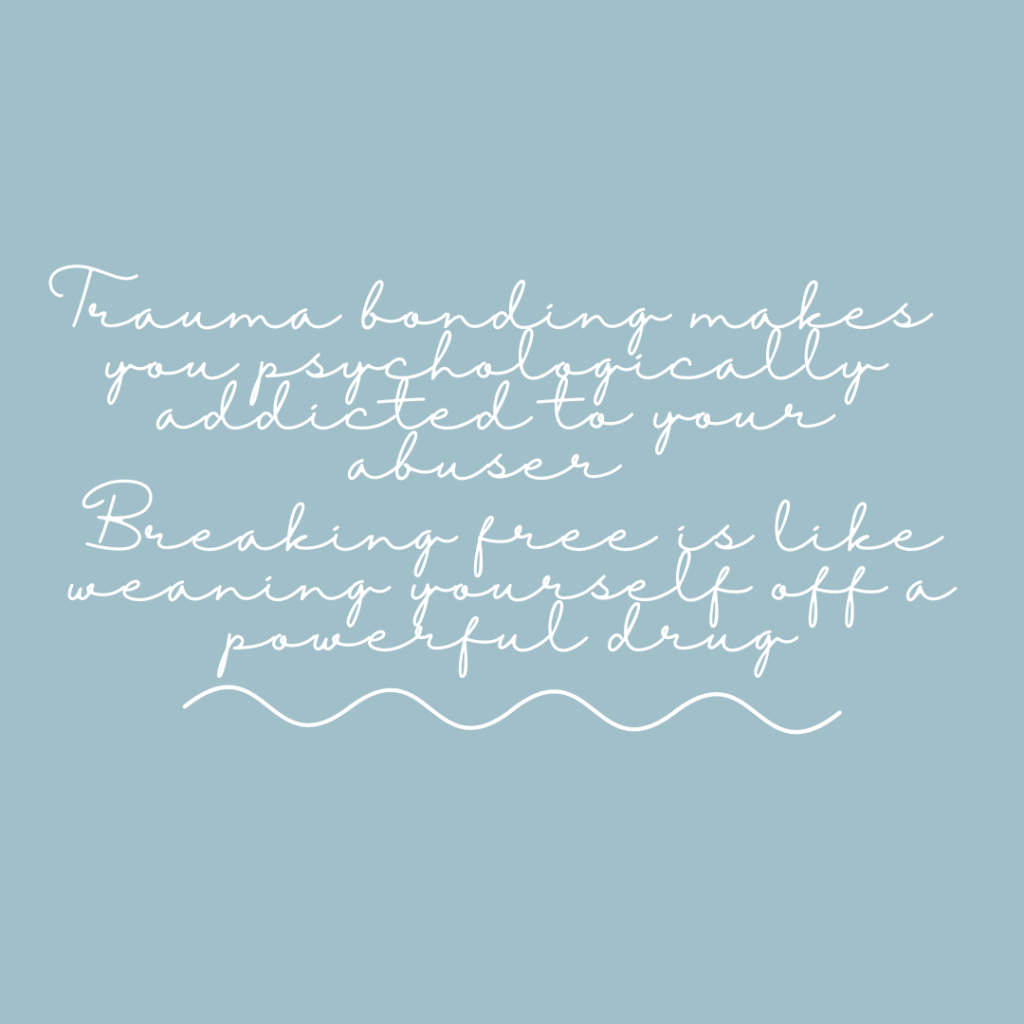When we think of an abusive relationship, physical violence is most likely what comes to mind. However, narcissistic, emotional, and mental abuse is a much less-understood and often overlooked form of emotional manipulation that can be just as harmful, if not more so. A significant aspect of narcissistic abuse is trauma bonding, the emotional attachment between a victim and their abuser. I want to share and explore the reality of trauma bonding, how it is tied to narcissistic abuse, and how it can be seen or covered by other symptoms. By sharing information about trauma bonding, I hope to raise awareness about the dangerous nature of emotional abuse and provide a better understanding of its effects on victims.

What is Trauma Bonding?
Trauma bonding is a psychological event that happens when a victim forms a strong emotional attachment to their abuser, often due to a cycle of abuse and constant reinforcement. This bond is created when the abuser switches between situations of love and kindness, followed by manipulation, control, and cruelty. The victim becomes addicted to the “high” of receiving love and affection, making it difficult to break free from the relationship even when they recognize it is hurtful or abusive.
Trauma bonding is very common in relationships involving narcissistic abuse. The abuser, often driven by their need for admiration and control, will create what could be seen as a push-pull dynamic in the relationship. They will shower the victim with love and attention, only to suddenly withdraw it and replace it with criticism, manipulation, or other abusive behaviors. This pattern keeps the victim in constant confusion and emotional turmoil, making it difficult to recognize the abuse for what it is and leaving them vulnerable to further manipulation. This cycle or pattern continues for longer or shorter times depending on if or when the abuser thinks that the victim might be catching on to them.
When a person is trauma bonded to another person, they often become enmeshed. You have no emotional independence or separation when you become enmeshed with someone. You no longer have autonomy from the other person. You count on that person for all your emotional support and excessively depend on them. You no longer have a sense of self, have a hard time functioning alone, are unable to think separately without feeling like you are betraying the other person, and you do what others want to do for fun rather than what makes you happy.
This type of bonding can also be compared to Stockholm Syndrome, where hostages develop positive feelings towards their captors. However, trauma bonding can occur in various relationships, such as romantic partnerships, parent-child relationships, and friendships.
In my relationship with my ex-husband, the cycle of abuse started even before we started officially dating and lasted until the end of our marriage. Because this started so early, like many abusive relationships, the cycle time would be very based on how sucked into the relationship I was. It was almost as if he knew how far he could push and hurt me before he had to start the cycle again. The trauma bond was so bad at one point that I felt I couldn’t do anything without him. I couldn’t make day-to-day decisions, I wasn’t happy without him, and making him happy was all that was important to me.
Manifestations and Masking of Trauma Bonding
Trauma bonding can manifest in several ways, and its symptoms may be masked by other factors, making it hard to recognize. Here are some common manifestations and how they can be hidden:
- Denial: Victims of trauma bonding may deny the abuse or minimize its severity. This can be a coping mechanism to protect themselves from the pain and cognitive dissonance caused by their attachment to the abuser. They may rationalize the abuser’s behavior, making excuses for them or blaming themselves for the abuse.
- Isolation: Abusers often isolate their victims from friends and family, making it harder for the victim to seek help or recognize the severity of the situation. The victim may also withdraw from their support network, fearing judgment or feeling ashamed.
- Low self-esteem: Victims of trauma bonding often suffer from low self-esteem, as the abuser constantly undermines their confidence and self-worth. This can make it difficult for the victim to believe they deserve better treatment or can survive without the abuser. Low self-esteem may also be masked by a facade of confidence or independence, making it difficult for others to recognize the victim’s internal struggle.
- Anxiety and depression: The emotional turmoil caused by trauma bonding can lead to anxiety and depression. These could be connected to other life stressors rather than the abusive relationship, making it difficult to connect the dots between the victim’s mental health and the abuse they’re experiencing.
- Codependency: Trauma bonding can create a codependent relationship, where the victim becomes reliant on the abuser for emotional support, validation, and self-worth. This dependency may be mistaken for love or loyalty, making it difficult for the victim and those around them to recognize the dysfunctional nature of the relationship.
I found myself in each of these. While there were times that I questioned if I was being abused, I was so dependent on him and isolated from my friends and family that when I questioned him, he could explain it all. And when he did, I believed him. He would tell me that my anxiety was for no reason and that I overreacted to everything (he was gaslighting me), so I would hide it from him and everyone around me. I honestly had no idea how strong the trauma bond was. I now know why it was so hard to leave, but I was so confused and hurt when I was in the thick of it. I honestly thought I was nothing without him.

Breaking Free from Trauma Bonding
Breaking free from trauma bonding is challenging and complex, requiring time, support, and professional help. Here are some steps to begin the journey toward healing:
- Acknowledge the abuse: Recognizing and admitting you are in an abusive relationship is the most important step in breaking free. It’s essential to acknowledge that the abuser’s behavior is not your fault and that you deserve better.
- Seek support: Reach out to trusted friends, family members, or support groups to share your experiences and seek guidance. Surrounding yourself with people who understand and validate your feelings can be invaluable in healing.
- Establish boundaries: Setting firm boundaries with the abuser is necessary for regaining control and protecting yourself emotionally. This may involve cutting off all contact, blocking their phone number and social media accounts, or seeking a restraining order if necessary.
- Professional help: Therapy, specifically with a therapist experienced in treating trauma and abuse survivors, can provide invaluable support in processing your emotions, identifying unhealthy patterns, and developing coping strategies. They can also help you rebuild your self-esteem and work on establishing healthy relationships in the future.
- Self-care: Prioritize your emotional, mental, and physical well-being. This may include exercise, eating well, getting enough sleep, and engaging in activities that bring you joy and relaxation. Practicing self-compassion and self-love can be instrumental in healing from trauma bonding.
- Be patient: Recovering from trauma bonding is a lengthy process that may involve setbacks and challenges. Be patient with yourself and recognize that healing takes time. Celebrate small victories and acknowledge your progress, even if it feels slow.
I feel that I had broken the trauma bond before I finally left my marriage; it was years from when I started seeing the patterns and making decisions for myself before I left. People often tell me that they have done all the steps, but the bond is still so strong and hurts so much, and all I can say is it takes time, a lot of time.
Trauma bonding is a powerful and subtle aspect of narcissistic abuse that can trap victims in a cycle of manipulation, control, and emotional turmoil. Understanding the nature of trauma bonding and its manifestations can raise awareness about emotional abuse’s hidden dangers and support those affected. Breaking free from trauma bonding is a challenging journey. Victims can reclaim their lives and build healthier, happier relationships with the right resources, support, and perseverance.




My son took his own life mostly due to trauma bonding…
I am so sorry to hear that, my heart breaks for you. It is such a horrible cycle to be in.